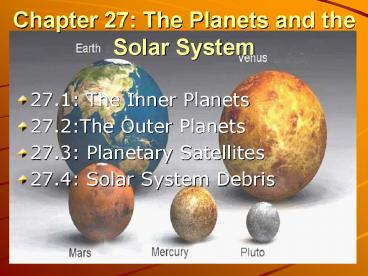Chapter 27: The Planets and the Solar System - PowerPoint PPT Presentation
1 / 19
Title:
Chapter 27: The Planets and the Solar System
Description:
3. Titan is the only moon with a substantial atmosphere. The ... left after a meteor strikes the Earth. Why are there more craters on the moon than on the Earth? ... – PowerPoint PPT presentation
Number of Views:483
Avg rating:3.0/5.0
Title: Chapter 27: The Planets and the Solar System
1
Chapter 27 The Planets and the Solar System
- 27.1 The Inner Planets
- 27.2The Outer Planets
- 27.3 Planetary Satellites
- 27.4 Solar System Debris
2
27-1 The Inner Planets
- Two Planetary Neighborhoods
- What is at the center of our solar system?
- What are the Terrestrial Planets composed of?
The Sun
Rock
3. What are the Jovian Planets made-up of?
Gas
3
27-1 The Inner Planets
- B. Mercury
- Nearest the sun
- Fastest revolution (88 days)
- Rotates every 59 days
- What did Mariner 10 do?
- 5. Surface temperatures vary from 400ºC to
200ºC.
Took photographs of the surface
4
27-1 The Inner Planets
- Venus
- Earths sister planet
- Rotates from east to west every 243 days
- Orbits the sun every 225 days. What does this
mean? - 80 is covered with lava and the atmosphere is
mostly sulfuric acid. - Surface temperature is 475ºC. Why is it so hot?
The Day is longer than the Year
Greenhouse Effect
5
27-1 The Inner Planets
- Mars
- 687 days to orbit the sun.
- What is its atmosphere made of?
- It has four seasons.
- It has polar ice caps.
- What is the name of the largest volcano in the
solar system? - Is there life on Mars?
95 C02 5 N Ar
Olympus Mons
Maybe?
6
27-2 The Outer Planets
- The Jovian Planets
- What invention led to the discovery of these
planets? - What are Jovian planets composed of?
- The temperature and density increases with depth.
- How do rings form?
The Telescope
Gas
Gravitational pull on free gas and dust particles
7
27-2 The Outer Planets
- B. Jupiter
- 11.9 years to orbit the sun
- Rotates every 10 hours
- Largest planet in the solar system
- It has a red eye
8
27-2 The Outer Planets
- Saturn
- 30 years to complete one orbit
- Rotates every 10 hours
- Lowest density of any planet
- Radiates more energy than it receives
9
27-2 The Outer Planets
- D. Uranus
- 84 years to complete one orbit
- Average temperature is 200ºC
- Rotates every 17 hours
10
27-2 The Outer Planets
- Neptune, Pluto, and Charon
- 165 years to complete one orbit
- Rotates every 16.1 hours
- Winds up to 2000km/hr
- Average temperature is 225ºC
- Neptune and Pluto switch orbits every 248 years
- Pluto is the ____ Planet. Or is it even a
planet? - Who is Charon?
Moon of Pluto
11
27-3 Planetary Satellites
- Satellites of Earth and Mars
- Bodies that revolve around planets are called
satellites or moons. - Who are Phobos and Deimos?
- How many moons do we have?
The moons of Mars
One
12
27-3 Planetary Satellites
- B. Jupiters Moons
- Has at least 28 moons
- Which one is geologically active?
- Which one has water?
- Which one is the largest in the Solar System?
- Which one is the most heavily cratered in the
Solar System?
Io
Europa
Ganymede
Callisto
13
27-3 Planetary Satellites
- Saturns Moons
- Has at least 24 moons
- Which one is the largest?
- 3. Titan is the only moon with a substantial
atmosphere. - The moons of Uranus and Neptune
- Uranus has 21.
- Neptune has 8.
- Triton has Ice volcanoes
- Miranda has been shattered as many as five times.
Titan
14
27-4 Solar System Debris
- Comets and TNOs
- Collisions create craters.
- Comets-Dirty snowballs made of dust particles
trapped in a mixture of water, carbon dioxide,
methane and ammonia. - What are TNOs? Where are they found?
- What creates the tail?
Trans Neptunian Objects
The Oort Cloud
Solar Wind
15
27-4 Solar System Debris
- B. Asteroids
- Asteroids -Solid, rocklike masses.
- How big are they?
- Where do we find asteroids?
- What happens if they hit earth?
Most are less than 1km long
In the Asteroid Belt between Mars and Jupiter
16
27-4 Solar System Debris
- Meteors, Meteoroids and Meteorites
- 1. Meteoroid - Rock or icy fragment traveling in
space. Smaller than an asteroid. - 2. Meteor - Shooting star, created when a
meteoroid enters the atmosphere and begins to
burn up.
17
27-4 Solar System Debris
- 3. Meteor Shower - occurs when Earth passes
through the tail of a comet, and particles from
the tail plunge through the atmosphere. - 4. Meteorite - part of a meteoroid that strikes
the Earth.
18
27-4 Solar System Debris
- What are the three main types?
- ..
- Which is the most abundant source?
- Why is Antarctica a good place to find
meteorites?
Stony 94
Iron 5
Stony/Iron 1
Antarctica
It is white and there is little weathering
19
27-4 Solar System Debris
- Impact Craters
- are bowl-shaped depressions left after a meteor
strikes the Earth. - Why are there more craters on the moon than on
the Earth?
It doesnt have an atmosphere, weather or Plate
Tectonics.































